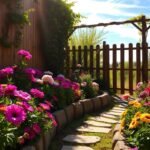Imagine stepping into a vibrant outdoor area where natural beauty meets thoughtful planning. For those with mobility needs, an accessible garden isn’t just a luxury—it’s a gateway to independence and joy. By rethinking traditional layouts, you can craft spaces that welcome everyone, from wheelchair users to parents pushing strollers.
Raised beds and smooth pathways turn gardening into a stress-free activity. Studies show well-designed green areas reduce stress by up to 60% while boosting property value. These features aren’t just functional—they create inviting environments where you can connect with nature without barriers.
Inclusive spaces benefit more than you might think. They help people using walkers, those with balance concerns, or anyone who prefers easy navigation. Want inspiration? Explore creative gardening ideas that blend accessibility with style, like vertical planters or repurposed containers.
This guide will show you how to build a sanctuary where mobility challenges don’t limit the thrill of growing plants. You’ll discover practical tips for smooth surfaces, multi-level seating, and smart layouts. Let’s transform your yard into a place where beauty and freedom grow side by side.
Understanding the Fundamentals of Accessible Garden Design
Creating an outdoor space that welcomes everyone starts with smart planning. Think beyond ramps and rails—true inclusivity means crafting areas where movement feels effortless and enjoyment comes naturally. Whether you’re reshaping an existing yard or starting fresh, these principles help everyone connect with nature on their terms.
Building Confidence Through Smart Layouts
Wide, smooth paths do more than guide visitors—they empower independence. Aim for walkways at least 4 feet wide (1.2 meters) with firm surfaces like stamped concrete or compacted gravel. These choices let wheelchair users glide smoothly while helping others avoid tripping.
| Feature | Traditional Garden | Accessible Space |
|---|---|---|
| Path Width | 2-3 feet | 4+ feet |
| Surface Texture | Uneven stone | Non-slip finish |
| Rest Areas | Rare benches | Seating every 30 feet |
Planning for Real-Life Needs
Place seating spots where paths meet flower beds or water features. These resting points become social hubs where people can chat while deadheading roses or filling bird feeders. Remember: accessible spaces work best when they’re beautiful and practical.
Lighting matters too—install path lights at hip height to help those with limited vision. Choose plants with varied textures and scents near seating areas. A lavender border isn’t just pretty; its fragrance helps orient visitors as they explore.
Designing Smooth and Wide Pathways for Wheelchair Users

Thoughtful pathway design turns any yard into an inclusive retreat. The right materials and spacing let wheels glide smoothly while keeping the space visually appealing. Start by choosing surfaces that balance functionality with natural charm.
Smart Material Choices Make All the Difference
Gravel offers a budget-friendly option when installed correctly. Use a three-layer system: crushed concrete base, compacted middle layer, and fine top gravel. This creates a firm surface that stays put under wheels. For modern spaces, consider poured rubber or Tarmac—both provide smooth rolling with minimal upkeep.
Safety First: Clearance and Navigation Tips
Paths should be wide enough for two adults side-by-side (at least 4 feet). This width accommodates wheelchairs and companions comfortably. Keep edges defined with low borders to prevent stray gravel. Gentle slopes (1:12 ratio max) help rainwater drain without creating puddles.
Remember to connect pathways to key features like raised beds or seating areas. Regular maintenance—like refilling gravel gaps—keeps routes safe year-round. With smart planning, your paths become invitations to explore, not obstacles to avoid.
Implementing the Practical Garden Design Layout for Wheelchair Accessibility

Accessible gardening thrives when you rethink traditional setups. Raised beds and mobile containers let you customize growing areas while keeping mobility needs front-and-center. These solutions create spaces where everyone can dig in comfortably.
Smart Solutions for Elevated Growing
Raised beds shine when built at 24-30 inches tall—this height eliminates bending. Keep them under 4 feet wide so plants stay within easy reach from chairs. Pair them with wide pathways (at least 3 feet) for smooth wheelchair movement.
- Mobile planters with locking wheels adapt to changing needs
- Wall-mounted systems save space while keeping herbs at eye level
- Multi-tiered beds accommodate users of different heights
For small spaces, try square-foot gardening techniques in raised containers. This method boosts yield while keeping maintenance simple.
Breathing New Life Into Existing Layouts
Don’t rip out mature flower beds—build up instead. Add retaining walls to create elevated tiers. Convert slopes into terraced areas with gradual ramps. Use these upgrades to improve access without losing established plants.
| Feature | Before | After Modification |
|---|---|---|
| Ground-Level Bed | Hard to reach | Edge seating added |
| Narrow Path | 28 inches wide | 42 inches with firm surface |
| Steep Slope | Uneven terrain | Gentle switchback path |
Rolling containers let you rearrange your design as needs change. Explore adaptive layouts that blend beauty with smart access. Remember—good gardening spaces grow with their users.
Planning for Future Needs: Long-Term Garden Accessibility

A truly welcoming outdoor space grows with its users over decades, not just seasons. As landscape designer Mark Lane notes:
“None of us know what’s round the corner—so it’s worth future-proofing your space to some extent.”
While homes must meet accessibility standards, yards often get overlooked. Smart planning today saves money and effort tomorrow.
Anticipating Life’s Curveballs
Ask yourself: Could narrow paths become problematic if mobility changes? Would raised beds still work if bending gets harder? Consider these factors:
- Modular planters that adjust height as needs evolve
- Extra-wide path bases allowing easy widening later
- Multi-generational seating areas with varying seat heights
Smart Upgrades That Age Gracefully
Choose materials that last 20+ years, like powder-coated steel beds or permeable pavers. Leave empty zones for future ramps or climate-adaptive features. Lane suggests: “Install key access points during initial design—retrofitting costs triple.”
Remember, great spaces serve toddlers learning to walk and grandparents using walkers. By building flexibility into your plan now, you create a living area that adapts as gracefully as the plants within it.
Adapting Garden Structures for Enhanced Wheelchair Access

Transforming garden structures opens new possibilities for inclusive enjoyment. Whether updating an existing pergola or adding ramps, thoughtful adjustments create seamless transitions between features. Let’s explore how to rework these elements without sacrificing style.
Rethinking Vertical Features
Pergolas and arbors become welcoming when you prioritize clearance. Widen entrances to 36 inches minimum—this allows easy wheelchair passage while vines climb overhead. Replace steps with gradual slopes (1:12 ratio) leading into shaded areas.
| Structure | Traditional Entry | Accessible Update |
|---|---|---|
| Arbor | 28-inch opening | 42-inch clearance |
| Gazebo | Step-up entrance | Integrated ramp |
| Trellis | Ground-level base | Elevated planter edge |
Smart Mobility Solutions
Ramps need more than just slope adjustments. Landscape architect Tina Smith advises:
“Install dual-height handrails at 34 and 38 inches—this accommodates both seated and standing users.”
For steep terrain, platform lifts with non-slip surfaces offer safe elevation changes.
Consider these upgrades:
- Flared ramp ends (36 inches wide) for smooth turns
- Weather-resistant grab bars near seating spaces
- Modular lift systems that blend with stone walls
By reworking structural features, you create unified areas where movement feels effortless. These changes let everyone experience the garden’s magic—from fragrant arches to elevated viewing platforms.
Creating Sensory-Rich Garden Spaces

Transform your outdoor area into a sensory haven where every touch and scent tells a story. Engaging multiple senses turns ordinary spaces into therapeutic retreats, especially valuable for those experiencing nature from seated positions. Let’s explore how textures, scents, and sounds can work together to create unforgettable moments.
Engaging Through Scents and Textures
Position fragrant flowers like jasmine and gardenias near seating areas. Their sweet aromas float best at wheelchair height—plant them in elevated containers or window boxes. For touchable interest, mix feathery grasses with rubbery succulents along pathway edges.
| Element | Traditional Approach | Sensory Focus |
|---|---|---|
| Border Plants | Visual appeal only | Lemon thyme (crushable leaves) |
| Path Edging | Plain concrete | Ribbed stone for tactile feedback |
| Seating Areas | Standard bench | Perfumed climbers overhead |
Bright marigolds and purple salvias create high-contrast displays that pop against green foliage. These color combos help visitors with low vision navigate while adding visual joy.
Harmonizing Light and Soundscapes
Soft solar lights under shrubs cast gentle glows that guide evening strolls. As horticultural therapist Emma White suggests:
“Wind chimes tuned to C and G notes create calming frequencies proven to lower heart rates.”
Consider these sound-enhancing features:
- Bubbling rock fountains near resting spots
- Native grasses that whisper in breezes
- Bird feeders attracting chirping finches
Rotate seasonal elements like spring-blooming hyacinths and autumn crinkly leaves. This keeps your garden engaging year-round while supporting local ecosystems.
Choosing Low-Maintenance Plants for a Carefree Garden
Selecting the right greenery turns your space into a thriving retreat without constant upkeep. Focus on species that balance visual appeal with resilience, letting you enjoy nature’s beauty while minimizing effort.
Easy Care, Drought-Tolerant, and Resilient Plant Varieties
Grasses and perennials like lavender or sedum shine in accessible spaces. As designer Mark Lane notes: “Trim them once yearly, and they rebound stronger each season.” These options thrive with minimal watering, perfect for busy lifestyles or container setups in urban areas.
Consider these smart picks:
- Dwarf serviceberry shrubs: Compact size with spring blooms
- Bearberry groundcover: Evergreen leaves that suppress weeds
- Wild columbine: Hummingbird-friendly flowers for shaded spots
Watch plant placement carefully. Overhanging branches that brush hips could hit wheelchair users’ faces. Choose upright trees like columnar oaks, and prune lower limbs for clear sightlines.
Herbs like rosemary and thyme add fragrance without fuss. Pair them with tactile grasses or velvety lamb’s ear near seating areas. This approach creates sensory interest while keeping maintenance light—so you spend less time working and more time enjoying.






